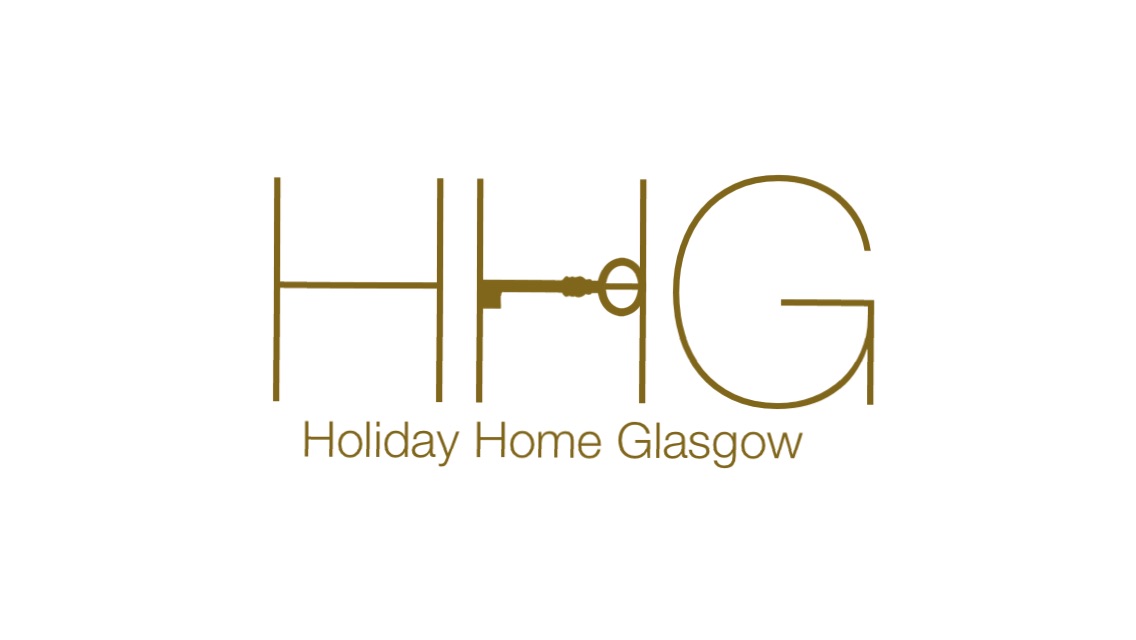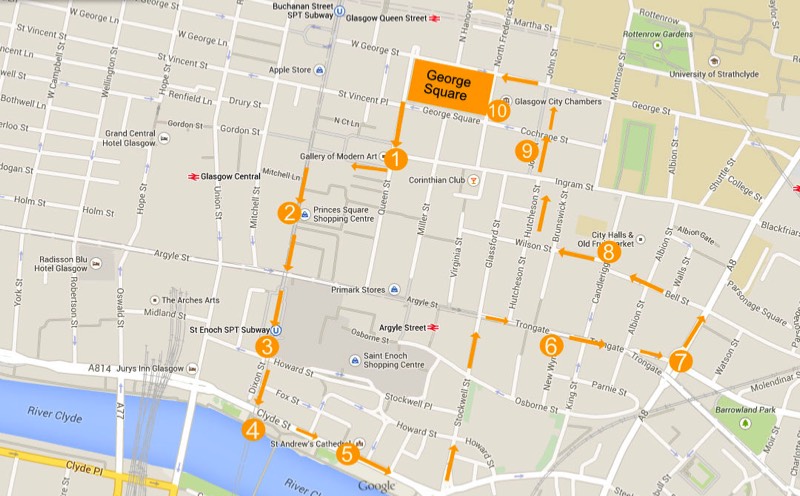Start at George SquareWe suggest starting your journey at George Square. The Square is one of Glasgow’s most famous landmarks and easy to find from Glasgow Queen Street Station (Directly Outside) and Glasgow Central Station (5 minutes on foot). This grand square stands at the heart of the city and displays statues of the greats in Scottish and British History.
- Robert (Rabbie) Burns – Poet – 1877
- Queen Victoria – 1854
- Prince Albert – 1866
- James Watt – Inventor – 1832
- Thomas Graham – Chemist 1872
- The Cenotaph – War Memorial 1921
- Robert Peel – Prime Minister – 1859
- John Moore – War Commander – 1819
- Scott Monument – Sir Walter Scott 1837
- Thomas Campbell – Poet 1877
- James Oswald –Parliament - 1856
- Lord Clyde – Army Commander – 1868
- William Ewart Gladstone – Prime Minister – 1902
From the square head to the south-west corner of the square (Queen Street) and walk just over 100 yards to the Gallery of Modern Art.
1. Gallery of Modern Art and the Duke of WellingtonGlaswegians are well known for their “wicked” sense of humour and fun loving nature. No-where else in Glasgow is this so apparent than at the Equestrian statue of the Duke of Wellington on Queen Street. This statue stands at around 30 feet tall and has been made famous due to the fact that the locals have been placing a traffic cone on the Dukes head for over 30 years. The council remove it and the locals put it back on. The cost to
Glasgow City Council has thought to have reached around £10,000 per year until in 2013 when a facebook campaign called “keep the cone” accrued more than 72,000 “likes” in one day. The practice of removing the cone has all but been forgotten and the cone remains in situ for all to enjoy.
After you have taken a few selfies with the Duke you could take a wander through the Gallery of Modern Art. The gallery is free to enter and displays works that portray the interests of worldwide artists. Throughout the year there is an array of exhibitions and events – Check out their timetable –
Glasgow’s Gallery of Modern Art When exiting the gallery take the first right, along the side of the gallery in Royal Exchange Square. Head through the archway at
Rogano’s Glasgow – This fine art deco eatery was born in Glasgow in 1935. To this day it serves the finest fish and seafood dishes from our Scottish waters and has won many culinary awards. Unfortunately you don't have time to eat…… you have shopping to do!
2. Buchanan Street and Princes Square Shopping CentreGlasgow’s Buchanan Street is one of the busiest pedestrianised streets in the city. Head south on the street and you will find the world famous
Willow Tea Rooms on the right hand side – They serve a traditional 3-tiered afternoon tea, in a setting designed by renowned architect and artist Charles Rennie Mackintosh.
Charles Rennie Mackintosh’s work is celebrated worldwide and visitors come to Glasgow especially to dine in these magnificent tea-rooms
Further along the street is one of Glasgow’s most stylish malls
Princes Square. In the late 1980’s this grade 2 listed building was transformed into a high end shopping and dining mall. Make sure you have your credit cards with you.
3. St Enochs Centre Don't burn your credit cards just yet as there is another shopping experience further down the street. Keep heading down Buchanan Street and cross the road at Argyle Street. This will lead you on to St Enoch Square, previously the site of a series of churches the
St Enoch subway station opened in the late 1800’s. The original ticket office remains in the square and now plays host to a branch of Caffe Nero’s
To the left of the ticket office you will find
St Enoch Square Shopping Mall, A large glass and steel building built in the late 80’s that houses lots of high street brand shopping and food outlets. Great if its raining…. Which it sometimes does in Glasgow.
4. The River ClydeOk now that your credit cards are on fire its time to cool, them down with a leisurely stroll along the River Clyde. The river runs through the city and was hugely significant during the reign of the British Empire. The Clyde is the 3rd longest river in Scotland and was an enormous success during the industrial revolution. Large ocean vessels would sail cargo such as tobacco and cotton to Port Glasgow and then smaller vessels would transport this up the shallow waters of the Clyde into the city where it would be stored in large warehouses in the
Merchant City Area.
Today it is an underused feature of the city but you will find locals sitting having a sandwich and watching the day go by.
5. St Andrew’s Cathedral
Half way along Clyde Street you will find
St Andrews Cathedral, built in 1816 and restored to its former glory in 2011. This sacred space allows visitors to wander through its Cloister Gardens and reflect on the day ahead. Keep heading along Clyde Street until you reach Stockwell Street on the left.
6&7. Trongate – Tron Theatre – Tolbooth Clock TowerKeep walking along Stockwell Street until you reach Trongate on the right hand side. Trongate is one of the oldest roads in Glasgow. It is the main route into the centre from the east of the city.
Before you reach the Clock Tower look out for the
Tron Theatre on the right hand side of the road. Originally this was a church, built in the 17th Century and one of the few remaining medieval buildings in Glasgow. This area of Glasgow fell into huge decline when the city started expanding west after the industrial revolution. It is still evident today with a number of derelict buildings still needing a facelift.
At the far end of the Trongate is Glasgow Cross (the original centre of medieval Glasgow) and the Tolbooth Clock tower, which is the last remains of the original city chambers destroyed by fire in the 1920’s. The tollbooth is where goods were weighed that had been shipped into the Clyde before they were taxed. It was also where Glasgow’s public hangings used to take place.
8. Merchant CityThis area of town is where Glasgow once housed all its merchant stock in huge warehouses. Cotton and Tobacco where the main trade in the area and with flower, fish and produce markets this area was a hub of activity.
In the late 1980’s the area saw increased investment with old warehouses becoming Classy restaurants, Loft apartments, Bars and Boutique Hotels. The area is now where the cool kids hang out and is a great place for a spot of lunch or a night out.
Merchant City Square which was formerly Glasgows old Fruit market is a perfect example of how this area has changed. From a once humble merchants market this square is now a stylish indoor/ outdoor venue for eating drinking and having fun.
9. The Italian Centre Crossing Ingram Street at Hutcheson Street you should now be on John Street. One of the first rebirths of Glasgow warehouses was on this street with the opening of the Italian Centre. This was built to celebrate all things Italian and you will find a selection of Italian designer stores and also the UK’s first Versace store here. It was a bold and popular reclaiming of derelict land and old Glasgow Tenements. Award winning architects Page and Park built a sheltered courtyard around a mixed-use scheme of housing, offices, shops, and cafes. Today it's a vibrant café area, with outside seating and a mixed crowd.
10. Glasgow City ChambersGlasgow’s most important and prestigious building is its
City Chambers. This grand, impressive building overlooking George Square was built in 1888 as a symbol of Glasgow’s wealth and political might. It has since been the home to successive Glasgow Councils. The building is open to the public with guided tours conducted twice daily. (10.30, 14.30) There is no need to book.


